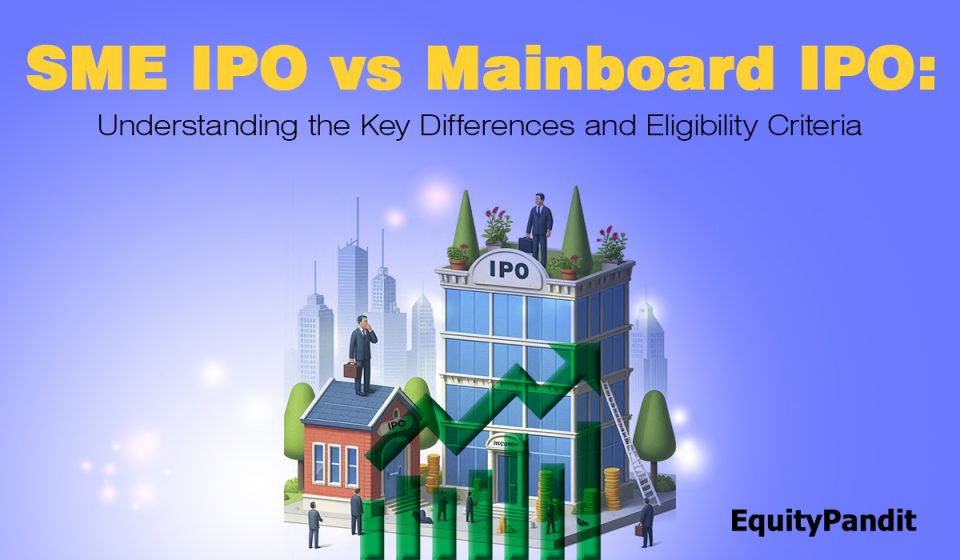Introduction
Have you ever invested in an IPO or Initial Public Offering? If yes, then you would have noticed that there are two types of IPO in terms of their entity and size of issue. An IPO depicts a company’s first issuance of shares to the general public to raise funds for the company’s growth and expansion. IPOs are divided into mainboard IPOs and SME IPOs based on their issue size.
The main difference between the two is over the size of offering, which for a mainboard IPO is larger compared to small and medium-sized enterprises. Other areas where differences lie are paid-up capital, minimum number of allottees, scrutiny of IPO prospectus, underwriting, minimum application size, and market making.
A) What is a Mainboard IPO? What are their eligibility criteria?
The Main Board IPO is the common IPO that is registered and transacted on NSE/BSE Stock Exchanges. For instance, it is designed for big corporates with at least a minimum paid-up capital amounting Rs 10 crores.
The SEBI ICDR Regulations 2018 define the listing criteria and eligibility for the Main Board IPOs.
SEBI IPO Eligibility Criteria
SEBI has established two ways for a company to qualify as an issuer of IPOs.
a) Profitability Route (Entry Norm I)
-For a company to be eligible for an IPO through this route, it must meet the following conditions in terms of profit standards:
-The company should have net tangible assets of at least Rs 3 crores in the three preceding years. For fresh issues (not OFS), of the above Rs 3 crores of tangible assets, at most 50% should be cash or cash equivalent.
– The company should have an average operating profit (before tax) of at least Rs 15 crore in any three of the last five years.
-If the company changes its name, 50% of the revenue generated in the previous year should come from the business carried on under the new name.
-The issue size should be at most five times the company’s net worth before the issue (pre-issue).
b) QIB Route (Entry Norm II)
The QIB route is an alternative route developed by SEBI for legitimate companies that are unable to meet strict profitability parameters. Companies going for an IPO through the QIB route have to ensure the following:
-IPO should be conducted through the book-building process.
-At least 75% of the net offering should be allocated to qualified institutional buyers.
-IPO subscription money should be refunded if the minimum allotment requirement is unmet. SEBI requirements for directors/promoters/founders/investors. There should be no disciplinary action against the company founders/promoters/directors/selling shareholders.
-Promoters/directors/founders/investors/issuing companies should not be barred from accessing the capital markets. However, a company cannot apply for an IPO until the debarment period has expired.
-The promoters/managers/founders/investors should not be associated with another company that is excluded from access to capital markets. The promoters/directors/founders/investors should not be defaulters.
– None of the promoters/directors/founders/investors can be labeled as fugitive offenders under the Fugitive Economic Offenders Act 2018. The promoters shall effectively or in its entirety own not less than 20% of the equity after IPO.
BSE IPO Eligibility Criteria
-According to BSE, the minimum paid-up capital of the company post-issue should be Rs 10 Crores.
-The minimum size of the issue must be Rs 10 Crores.
-The minimum market capitalization of the company issuing the shares should be Rs 25 Crores.
-It is necessary to adhere to the BSE Main Board IPO checklists and provide the required documents and information at each stage, including the Principle Approval Stage, Issue Opening Stage, Basis of Allotment Stage, and Listing and Trading Approval Stage.
NSE IPO Eligibility Criteria
Apart from SEBI’s IPO guidelines, the NSE mandates that the issuing company fulfils the following eligibility criteria:
– At least one promoter must possess at least 3 years of experience in the same industry.
– The issuing company is required to furnish the NSE with the annual reports for the preceding three fiscal years.
– The company must have a positive net worth. (This applies to companies with an issue size of less than Rs 500 Crores)
– The post-issue paid-up equity of the company should exceed Rs 10 Crores
– The market capitalization should surpass Rs 25 Crores
– The company must provide the Exchange with a certificate affirming that:
– No proceedings against the issuer under the Insolvency and Bankruptcy Law are pending.
– The company has not received a winding-up petition from the NCLT (National Company Law Tribunal).
B) What are SME IPOs? State the criteria for their listing.
An SME IPO refers to the initial public offering of a small and medium-sized enterprise. In essence, it essentially is an enterprise that has offered shares to the public via the stock market.
The funds raised from this type of offering will be required for the development of the business entity. With a relatively short history of being constituted, the SMEs are going to face difficulties in raising funds from financial institutions with traditional methods, especially the IPO process.
Each of the NSE and BSE has created a different platform for SMEs for IPO – NSE Emerge and BSE SME, respectively. Both trading platforms are supposed to be a facility for SMEs and start-ups to raise funds from the public.
SEBI kickstarts the process of SME IPOs by reducing the norms for SME IPOs in aspects of differences compared to the mainboard IPOs. This regulatory support, combined with the requirement that the post-issue paid-up capital of the company issuing the SME IPO should not exceed Rs 25 crores, creates a supportive and confident environment for SMEs.
Furthermore, SMEs must fulfil other eligibility requirements set by the exchanges. Understanding these criteria will ensure that you are well-informed and knowledgeable about the process for SME IPOs.
BSE SME IPO Eligibility
In order to be able to participate in the BSE SME IPO, small and medium enterprises (SMEs) have to meet the requirements set by BSE SME Platform.
The eligibility criteria for Listing SME IPO on BSE:
| Eligibility | Eligibility Requirement |
| Net worth | At least Rs 1 crore for 2 preceding full financial years |
| Net Tangible Assets | Rs 3 crores in the last preceding financial year |
| Track record (operations) | At least 3 years |
| Operating profits | Positive for 2 out of 3 latest financial years. |
| Leverage ratio | Not be more than 3:1. |
NSE SME IPO Eligibility
The NSE Emerge platform has specified certain conditions that a company must meet to issue an SME IPO:
– The company must be registered under India’s Companies Act 1956 or 2013.
– The company needs to have a track record (operations) of at least three years.
– The promoters must collectively or individually hold at least 20% of the share capital after the issue.
– One of the promoters should possess at least three years of experience in the same industry.
– The company must have operating profit and a positive net worth in at least two out of three fiscal years.
– There should be no ongoing case for the Industrial and Financial Reconstruction (BIFR), insolvency, or bankruptcy proceedings against the company or its promoters.
– The company should not have received any winding-up petition from NCLT/Court.
– No significant regulatory or disciplinary action should have been taken against the applicant company by any stock exchange or any agency in the last three years.
Key differences between Main Board IPO and SME IPO.
| Basis of difference | Main Board IPO | SME IPO |
| IPO offer documents | The IPO offer document, Draft Red Herring Prospectus (DRHP), is submitted to SEBI for vetting | The stock exchange observes and reviews the DRHP and prospectus; SEBI observation is not required. |
| IPO Timeframe | IPOs typically take around six months or longer to go public. | SME IPOs take 3 to 4 months for an IPO Issue and go public. |
| IPO underwriting | No underwriting is needed for IPOs that distribute 50% shares to qualified institutional buyers (QIBs). | The SME IPO must be 100% underwritten, and 15% of the underwriting should come from the merchant banker’s account. |
| Issue eligibility norms | SEBI has established strict and intricate standards for determining eligibility and issuing guidelines for mainboard IPOs. | The eligibility norms for SME IPOs have been made more lenient, primarily due to the inclusion of specific conditions that ease the regulatory requirements. |
| Listing Exchange | Main board IPOs are listed on the BSE and NSE exchanges. | SME IPO shares are listed on either BSE SME or NSE Emerge exchange. |
| Market making | Market making is not required for Mainboard IPOs after the issue. | Market making is required to ensure liquidity in an SME IPO. |
| Minimum application or trading lot size | The Mainboard IPOs typically require a minimum application value or trading lot of Rs. 10,000-Rs 15,000. | The minimum application size in an SME IPO is notably high, starting at Rs 100,000. |
| Number of allottees | At least 1,000 subscribers or allottees should be in the regular Mainboard IPO. | The minimum number of allottees for an SME IPO should be only 50. |
| Post-issue paid-up capital | Companies looking to be listed on the BSE and NSE exchanges must have a post-issue paid-up capital with a face value of Rs 10 crore. | For the small and medium-sized enterprise (SME) company, the post-issue paid-up capital of Rs 1 crore, with a requirement of Rs 25 crore, is a significant financial commitment. |
| Reporting | The audit of the financial statements of the company issuing the IPO needs to be carried out at every three months interval. | Every half a year audit of financial statements must be undertaken by SME companies. |
Frequently Asked Questions (FAQs)
What is the time frame for a mainboard IPO to go public?
Mainboard IPO can take 6 months or longer procedure to go public and raise funds.
What is the time frame for an SME IPO to go public?
An SME IPO can take three to four months to go public.
State one of the main eligibility criteria for an NSE SME IPO.
After the issue, the promoters must hold at least 20% of the share capital, collectively or individually.
In the case of an NSE SME IPO, the company has to be incorporated under which Act?
The company going for the NSE SME IPO must be registered under India’s Companies Act 1956 or the Companies Act 2013.
What are the minimum number of allottees in Mainboard and SME IPOs?
For the Mainboard and SME IPOs, the minimum number of allottees are 1,000 allottees and 50 allottees, respectively.
For which type of IPO, market making is compulsory?
For an SME IPO, the market making is compulsory.
The future of investing is here! Unicorn Signals leverages advanced AI technology to provide you with powerful market predictions and actionable stock scans. Download the app today and 10x your trading & investing journey!
 Live
Live

